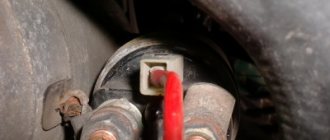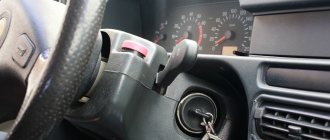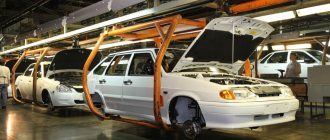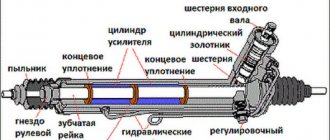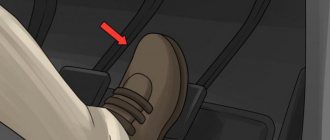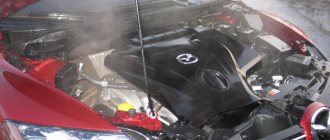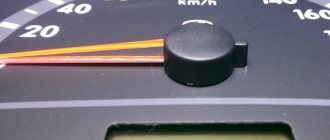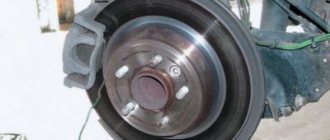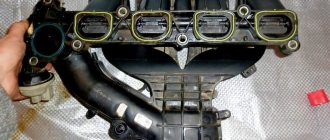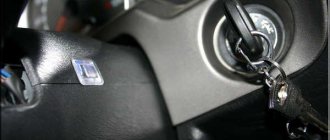Sometimes owners of cars of almost any brand experience a very unpleasant phenomenon that makes people pay attention to your car - a squealing sound from the starter after starting the engine.
Let's try to understand this unpleasant situation, what can cause such an unpleasant sound and how to deal with it.
I hope that you are familiar with the principle of operation of a car starter and know what a bendix (overrunning clutch) is. In a nutshell, this is a special clutch that, after starting the engine, mechanically disconnects the starter from the engine, thereby leaving no opportunity for the flywheel to spin the starter and destroy it. The principle of operation of the overrunning clutch is the same as that of a regular bicycle - torque is transmitted to one side, and the gear rotates to idle on the other.
At the moment the engine starts, when the starter starts the engine, the bendix should “rebound”, thereby disengaging the starter and flywheel, but for various reasons it happens that the bendix lingers in the extended position and squeals when rotating at high speed. What can keep the Bendix engaged with the flywheel?
- Malfunction of the starter retractor relay, fork, that is, the Bendix drive.
- The cause of squealing can also be an excessively worn bendix.
- This also includes a fairly common malfunction - contamination, damage to the splines on which the bendix runs.
Let's talk about the last malfunction, since it caused the starter to squeal; it was enough to simply disassemble the starter and clean it. But first things first, I’ll try to show in the photo what to clean and where.
Bendix remains in this position, although under the force of the retractor spring it must hide
The photo shows that when I pulled the bendix out with a screwdriver, it remained in that position, although it should have jumped back. As a result, the Bendix comes out, the engine starts, it does not hide, it rotates at high speed and squeals, since it is not new. To solve the problem, I disassembled the starter:
Removed the retractor
Starter in the process of disassembly
The front part of the Golf 2 starter has been removed
Shaft and worm dirty
Bendix isn't particularly clean either.
The dirt that was on the shaft and the bendix prevented the bendix from moving freely, so I decided to wash it. The Bendix itself was also washed in pure gasoline.
Wash the worm and starter rotor shaft
We do the same with Bendix.
Next, we collect and rejoice if the dirt was the cause of the squeal! Good luck!
Causes of extraneous sounds in the engine compartment during or immediately after starting the engine
Worn generator bearings
If you hear a whistle and other extraneous sounds when starting the engine, this may indicate various problems associated with its operation. As a rule, these sounds are not so much dangerous for the unit as they are annoying to the driver himself. However, if squeaking, clicking, or knocking noises from the engine occur, the problem must be addressed immediately.
Belts
So, if a whistle appears when starting the engine, then one of the most common causes of this problem is belts. The squealing noise may be due to wear on a particular belt or poor tension, and it may become louder as the crankshaft speed increases. But sometimes when you press the gas, the whistle may disappear altogether. If you hear a whistle when trying to start the engine, then first of all you need to check the tension of all drive belts.
If during the diagnostics you notice that one of the belts is loose, this in turn can lead to its slipping, which can lead to the appearance of sounds uncharacteristic of engine operation. In this case, tightening the strap can solve the problem. Remember that slipping can also be caused by dirt and engine fluid that gets on the straps. If this is the case, then the cause of the oil leak must be solved before replacing the belt; of course, you can try to clean it, but experts recommend changing them anyway (the author of the video is the channel In Sandro’s Garage).
As practice shows, most often ringing and squeaking when starting the engine is caused by the alternator belt, and extraneous sounds disappear after increasing the engine speed. This problem is fraught with insufficient battery charge, which, in turn, can lead to multiple consequences. Moreover, if the belt breaks, the battery simply will not be able to charge while the engine is running. As a result, a corresponding low battery indicator may appear on the dashboard; if this happens, you need to check the condition of the belt itself.
In some cases, the problem may be with the timing belt, and the consequences of such a malfunction will be more serious. The appearance of extraneous sounds may be due to wear of the bearings. If the strap itself breaks for some reason, this can cause the valves to bend, and such repairs, in turn, require large financial costs. Check the condition of the belt itself - there should be no signs of damage, peeling or cracks. If they are present, the strap must be replaced.
Rollers and bearings
The appearance of unpleasant rattles, pops and other third-party noises can occur due to the fault of bearing devices, as well as rollers. The engine design uses more than one bearing and roller, so it can be difficult to find the cause. From a normal whistle, the sound when rollers and bearings wear out will be lower; as a rule, it appears when the engine is running at idle speed. Moreover, when they increase, it will either disappear completely or be quieter. Worn rollers with bearings must be replaced before a more serious problem occurs (video author - IB Channel).
We recommend: Official Chery dealer
Intake system malfunctions
Grinding and popping noises, as well as crackling noises when starting the engine, sometimes occur due to malfunctions in the operation of the intake system. Of course, you should move on to this option when you are sure that the bearings, rollers and belts are working properly.
So, what malfunctions are typical for the intake system:
- Throttle valve. This unit sometimes jams, as a result of which it creates specific turbulence in the air flow. If the appearance of grinding and popping noises, as well as whistling, is caused by this particular problem, the damper must be completely flushed. Please note that to most effectively clean the unit, it will need to be completely dismantled.
- The reason may also be the intake valve, which is responsible for the circulation of crankcase gases. If it becomes clogged, it will prevent normal circulation of hot air; therefore, due to very high pressure, engine fluid may be squeezed out of the seals. To get rid of such a malfunction, the valve will need to be cleaned, but to do this it must first be removed. Depending on the design features of the engine, it can be located either on the crankcase ventilation pipe or on the valve cover. If the valve itself is made of metal, any substances that will not scratch the surface can be used for cleaning. If the device is made of plastic, then it is better not to use aggressive agents.
Turbine malfunctions
Most modern cars are equipped with turbochargers, the purpose of which is to increase engine power, as well as improve the driving characteristics of the car as a whole. However, it is another powertrain component that can cause knocking, grinding, and popping noises. If the engine starts and a knocking and grinding noise is heard, then there is a possibility that this problem is caused by an air leak in the place where the turbocharger and the power unit connect. As a rule, the appearance of sounds uncharacteristic of internal combustion engine operation indicates a failure of the turbocharger. This malfunction is more typical for diesel units (the author of the video is the MZTk Turbocom channel).
Starter
If you clearly hear a grinding noise, then there can only be one cause of the malfunction - the bendix, which is one of the main elements of the starter, for some reason cannot engage with the flywheel. The grinding noise itself appears as a result of skipping teeth. It should be noted that such a breakdown must be eliminated as quickly as possible, otherwise there is a possibility of damage to the gears of both the flywheel and the starter unit.
The following elements are subject to diagnosis:
- First of all, you should diagnose the mounting of the device - in practice, due to driving on uneven roads, the bolts that secure it may become unscrewed. This leads to the fact that the mechanism will be skewed, accordingly, the gear will lose contact with the flywheel. You need to dismantle the starter assembly and diagnose the condition of the bendix.
- If the problem lies in gear wear, then the efficiency of the mechanism will be significantly reduced. The grinding noise itself will appear as a result of the bendix bypassing, and if you do not deal with this problem as quickly as possible, the starter device may eventually stop turning the flywheel altogether. After dismantling, if the gear is really worn out, you will be able to see it without the help of specialists.
- There is a possibility that the bendix does not move well along the shaft and is not able to reach the flywheel. Try to dismantle it, and lubricate the shaft itself with engine fluid, then reinstall it and re-check the operation of the unit. It would not be superfluous to carry out diagnostics of the traction relay.
1. New and worn gear
2. Worn out bendix
No mechanical contact between gears
If the starter knocks when you turn on the ignition system and the solenoid relay works normally, but the engine does not start, then this problem is mechanical, and its reason is that the gear on the freewheel does not fit into the flywheel crown due to nicks formed on it teeth.
When moving forward, the bendix stops on these nicks, while the contact pins do not close the starter motor. As a result, after turning the key, only clicks are heard when the retractor is activated and dull blows when the flywheel and bendix gears collide.
A characteristic feature of this breakdown is that it manifests itself periodically; after the problem occurs, the car starts up normally again for some time. This comes from the relative position of the flywheel crown with the clogged areas. If they are opposite the teeth of the Bendix gear, the starter does not turn the crankshaft, and one defective tooth is enough for this. In all other cases there will be no problems with starting the engine.
To solve the problem when the starter rattles without engaging the flywheel, you need to turn the crankshaft a little. To do this, you need to turn off the ignition, set the gearbox to fourth gear, and then push the car. The crankshaft will rotate to the desired angle, and the car can be started. For large cars, it is better to jack up one of the drive wheels and turn it along with the crankshaft.
If the engine starts after turning the crankshaft, it is necessary to inspect the ring for defects. On many engines this can be done without removing the starter itself. To do this, remove the plug on the clutch housing and slide off the rubber cover on the clutch lever. We install the compact flashlight so that you can see the connector that opens after sliding the rubber cover.
We install a small mirror so that the teeth of the flywheel crown are visible. Through the hole from which the plug was removed, you can turn this gear using a screwdriver. At the same time, the teeth are carefully examined to see if they are deformed. If such a defect is identified, it will need to be eliminated. This is best done at a specially equipped station.
It should be noted that contacting an auto electrician or auto diagnostician for such a breakdown is simply a waste of money. If no grooves or other damage is found on the crown of faces, the problem lies in the starter itself.
Troubleshooting wires
Some drivers, in search of a malfunction, are in a hurry to remove the starter, but such hasty actions should not be taken, since often the problem of the engine not starting is due to wires, poor contacts or their absence. Here are the most typical defects:
- low weight of the engine and body;
- unreliable connection of the starter wires (plus of the rotor winding, main plus, power supply contact from the ignition switch to the solenoid relay (SR)).
If there is a bad ground on the engine, a sign of a defect will be a slight click on the first attempt to start, then all the instruments may go out, and with the next turns of the key any signs of “life” will disappear altogether (but not necessarily). Checking the presence of mass is quite simple, but the check needs to be done by two people:
- one of the participants closes the mass terminal of the battery with the engine housing with a metal object (for example, a wrench or a cigarette wire);
- the second person, sitting behind the wheel of the car, turns the key all the way to the right;
- If there really was a bad ground, the starter will immediately start turning at normal speed.
You should also ensure the reliability of all fasteners on the starter; to do this, perform the following steps:
- unscrew all the nuts on the starter, having previously removed the terminals from the battery;
- wipe the joints and fasteners with a dry, clean rag;
- treat contacts with WD-40;
- tighten the nuts with the necessary force; do not overtighten, otherwise you may break the thread.
If the BP wire is connected using a connector, bend the tongue of the “chip”; here the connection should be tight.
When, after cleaning all contact parts, the engine starts, it means that the malfunction has been eliminated, and there is no need to find out what caused the defect. If nothing has changed for the better, then you should definitely check the starter; to do this, the unit will have to be dismantled.
We recommend: Car accessories: where is the best place to order?
Why does the starter whistle when starting the Priora?
Now let's get serious. A sound that ate the nerve cells of more than one thousand drivers, making them blush in front of boys and beautiful girls. That same squealing pig under the hood. And all this is he - Starter! The problem is known on most Lada Priora older than 4-5 years. This misfortune has not spared my Porch, although it seems to be used little and carefully. The treatment is quite simple, which is what this post will be about. First things first. Tools: — Ratchet — Socket head 13 — Socket head 8 — Curved screwdriver — Pliers Time — about 2 hours.
So. First of all, disconnect the “-” terminal from the battery. Next, remove the air filter housing along with the mass air flow sensor, having previously disconnected the connector from it. We see the following picture
To remove, first unscrew the wire end nut. Then unscrew the 3 nuts securing the starter itself. The photo shows 2. Third from the bottom. We remove the starter from the engine compartment.
Next, we unscrew the 2 clamping bolts of the starter housing and get to the gear mechanism, which is clearly not full of lubricant.
Next, I personally disassembled the starter down to the screw for prevention. In order not to bore you, I will leave a link to a detailed manual of which there are many on the Internet HOW TO DISASSEMBLE THE STARTER
I took it apart to this extent.
After complete disassembly, wash out the old grease using gasoline or solvent. Particular attention to the gear mechanism and bendix. Well, bushings wouldn't be bad.
We carry out the assembly in the reverse order; you should be especially careful with the brush assembly. Lubricate all rubbing parts with grease. Personally, I recommend Chevron.
But I didn’t have it on hand, so I used Litol 24. The difference is small, but it is there.
We install it on the engine and enjoy the completely different sound of the starter. I was surprised how quietly it can work. Unfortunately there is no video. But take my word for it.
I am ready to answer all questions and suggestions both in comments and in private messages. I wish you all a smooth road and silence under the hood. Best regards, LadaRacing
The appearance of a squeal from the starter after turning the ignition key is an unpleasant problem, to say the least. However, like most other problems, it can be solved. And since the engine is still not a pig, you shouldn’t let it “squeal”, because the problem is quite serious, and if you postpone its solution “for later”, the cost of the solution will increase sharply.
Why doesn't the starter turn on a hot engine? And we know the reason
Yesterday everything was fine, but today I was tormented by the question of why the starter does not turn on a hot engine. This question may arise from owners of both domestic cars and foreign manufacturers. This phenomenon is very unpleasant, especially for owners of cars with an automatic transmission. In such a situation, a car with a “mechanics” can be started from a tow; sometimes a simple push will be enough to start the engine, but the automatic transmission is not provided for this kind of action. We will explain in this article why the starter does not turn on a hot engine, as in the instructions for car operation does not affect this problem. The story cannot be addressed to any specific model, because the symptoms are the same for all brands of cars. There can be several reasons for such an unpleasant situation for the driver. Conventionally, they can be divided into two categories: engine problems and starter malfunctions. We will try to highlight as many problems with these systems as possible. Why do you need a starter? For many years, since the advent of the first “self-propelled wheelchairs,” which later became known as cars, the engine was started by rotating the starting handle. As long as the engine had one or two working cylinders, this was not difficult to do. An increase in the number of cylinders and their volume required a significant increase in effort to start the power unit. Therefore, the efforts of designers were aimed at solving this problem. The result of their work was the invention of the electric starter. The appearance of such an “assistant” made it possible to start the engine without leaving the car, simply by turning the ignition key or pressing a special button. The starter is a complex electrical device in which the energy accumulated by the battery is converted into rotational movement of the armature. A gear is mounted on the armature shaft, which, when engaged with the engine flywheel, starts it. Signs of malfunctions Like any complex technical device, the starter can sometimes fail to operate. The failure can be complete or partial, related to the device itself or to the devices serving it. In such cases, engine problems cannot be ruled out, regardless of whether it is carburetor or injection. We will not consider the complete failure of this device, but will focus on its partial problems when starting the engine. We can say with great confidence that most drivers with driving experience have had to deal with a situation when in the morning, after an overnight stay, the engine started almost instantly, and when hot, it shows no signs of life. Let's look at this situation in more detail. First, let's look at the problems with the starting device. As you know from the physics course, bodies tend to heat up when heated. This device was no exception. Thermal expansion of the contact wire with the retractor terminal, especially with loose contacts, leads to loss of contact in this connection. The electrical resistance of such a contact increases to such a value that it is unable to provide sufficient current to the electric motor of the starting device. Because of this, it cannot develop sufficient speed to start the engine confidently. The culprit may be worn starter bushings, which are made from a copper-graphite alloy that is subject to wear. If the car starter has been in operation for a long period, an excessive gap will form between the shaft and the bushing. When the shaft rotates, it is pressed and engages the stator windings, which makes it difficult and sometimes completely stops the rotation. It is impossible to exclude the solenoid relay as a source of problems, in which problems with power contacts arise when overheated. Electricians note repeated cases of failure to solder the coils of the solenoid relay with the terminals for connecting the power supply to them. This “minor” malfunction creates difficulties in eliminating it, since it needs to be removed from the car, which is very difficult. The battery may also be on the list of culprits if it has insufficient charge. In a cold state, the compression in the working cylinders of the engine is somewhat underestimated, so the energy of such a battery is sufficient for starting. After the engine warms up to operating temperature, it increases, which creates additional loads on the starter that it is not able to overcome. In some cases, the reason may even be trivial. The culprit may be poorly tightened terminals on the battery or their oxidation. As you can see, problems with starting a hot engine do exist, there can be many more of them than are touched upon in this article. We tried to tell you why the starter does not turn on a hot engine; this can be used as a basis for troubleshooting and troubleshooting problems. If additional questions suddenly arise, today they can easily be found on the Internet or by reading specialized literature.
What is a starter and how does it work?
Let's briefly touch on the basics.
So, the starter is based on a DC electric motor. At the front end of its shaft there is a sliding coupling and a gear, which at the moment of start-up engages with the teeth of the engine flywheel. The movement of the clutch is ensured by a retractor relay located on the starter housing. At the moment of startup, the relay rod moves and pulls the fork, which pushes the clutch and gear into the position of engagement with the flywheel.
The traction relay coil has two windings.
Accordingly, all malfunctions come down to either problems with the retractor, or with the electric motor itself, or with the clutch.
As a rule, the starter refuses to start the car at the most inopportune moment and completely unexpectedly. That is, yesterday everything was fine, but today we turn the key to the “start” position, but it doesn’t turn... or it turns but somehow not the way it should, or it makes strange sounds. In any case, there is no need to wait for a miracle; it will not go away on its own. Let's try to find and fix the problem.
Reasons for failure to start the internal combustion engine related to the battery
The simplest reason why a car won’t start is a dead battery; its condition is checked by measuring the voltage using a multimeter. When connecting the probes of the measuring device to the battery terminals, the voltage on the voltmeter should be from 12.4 to 12.8 Volts; if it is less, the battery must be charged. A sign of a dead battery is a decrease in the brightness of the instrument panel lights when you try to start the engine. When the battery is completely drained, then the instruments are no longer illuminated; of course, there are no sounds when you turn the ignition key.
We check whether there are any oxides on the terminals and terminals of the battery, and also check the reliability of the connection of the wires on the battery. The terminal contacts can be easily washed with plain water (of course, you don’t need to do this in cold weather outside); for cleaning you can use sandpaper, a metal brush, or a special tool with a metal brush inside.
Causes
Why is there a crackling and grinding sound when starting the engine? This question is often asked by beginners and not-so-motorists. Many people are frightened by the strange sound heard when starting the engine. Although in many cases this is not a difficult problem. But it still needs to be eliminated, and for this it’s good to know where to look for the problem. There are several places that produce crackling and grinding noises during startup:
- Starter;
- Flywheel;
- Roller mounting bolt (timing).
Knowing the main places of breakdowns, you will quickly find out where the main problem is. For a more accurate diagnosis, open the hood and ask someone to start the engine. If there are problems with the starter and flywheel, a cracking noise will be heard from the rear of the engine when the bolt is unscrewed at the front.
Starter malfunction
If, when starting the engine, the starter makes one loud click and nothing else happens, in 100% of cases this is caused by problems in the module itself. One click indicates that charge is reaching the starter as the relay clicks. In this case, failure of the relay is excluded. The cause of the problem with the functioning of this module may be an unstable charge that reaches it. In this case, you should try to start the engine again, and repeat attempts at intervals of 20 seconds. Perhaps on the 2nd or 3rd try you will be able to start the car. If the engine still does not start, investigate the following potential causes of the problem:
- the starter bendix has failed;
- the retractor is broken;
- the main winding of the starter is broken;
- winding short circuit;
- brushes and bushings are worn out.
We recommend: What to check before buying a car
In the latter case, it is only necessary to replace the failed components.
In any case, regardless of the reason why this problem occurred, the first step is to inspect and check all contacts visible from the outside. Often the starter stops performing its functions normally due to weak contact in one or another node. An unstable charge is also a fairly common cause. In this case, you just need to repeat the attempt to start the engine several times. Most likely, after two or three attempts you will be able to start the engine, and a similar situation will not repeat during subsequent starts.
Even if you eventually managed to start the engine after some attempt, you should not consider the problem solved. Otherwise, at some point the car will simply stop starting and you will have to look for alternative ways to start the engine. You should not solve the problem by replacing the starter.
A car has long ceased to be a luxury. It’s hard to imagine life without a car these days. Many people drive a car every day and for any need - to work, study, dacha, shopping, on vacation. And that's why it becomes very bad when the car won't start. Plans are ruined, meetings are cancelled, people lose money!
We will look at situations where the starter works, but the car still does not start, another time. And now - about what to do if the starter on a Priora does not turn.
First, let's understand how a starter works and what its structure is. An electric motor with a gear that meshes with the engine flywheel and turns it when started. All this is hidden in a housing on which the solenoid relay is mounted. It is designed to move the gear and supply power to the electric motor.
When you turn the ignition key, current is supplied to the relay. Using an electromagnet, it is retracted, using a special mechanism, it moves the gear and starts the engine by closing the contacts. When the key is released, power stops being supplied to the magnet of the solenoid relay, the relay operates in the other direction and the contacts open. So, we know what the principle of operation of the starter looks like in general terms, so now it will be easier for us to understand why the starter does not turn on the Priora.
If you hear clicking sounds when you turn the ignition key and the lights on the instrument panel go out, it may be the battery. It needs to be checked, recharged, topped up with electrolyte or replaced. Is the battery OK? Then the situation becomes more interesting. Check the wires that come from the battery. If they get hot, check their contact with the battery. Remove them from the terminals, clean them, lubricate them (sometimes oxidation occurs) and install them back.
Check the connection between the ground terminal and the body. If necessary, clean this connection. Check the connection between the plus terminal and the starter. Determine if power is supplied to the solenoid relay from the ignition switch. To do this, you need to disconnect the connector from the relay, and turn the ignition key “to start” and measure the voltage at the connector.
The Priora starter still won't turn? Then you will have to remove it from the car and check it.
The removal procedure looks like this: disconnect the battery terminals, unscrew and remove the air filter, unscrew and remove the positive wire from the starter. Then disconnect the connector from the relay, unscrew the starter mounting nuts and remove it. We are already much closer to solving the question of why the Priora’s starter does not turn. Now we take the wires for lighting (crocodiles) and connect them with the negative wire of the battery and the starter housing. We connect the positive one to the relay connector, after which the gear should be activated and ejected forward. If not, change the retractor.
You can hook the negative wire to the starter housing, and the positive wire to the lower terminal of the solenoid relay. The electric motor didn't work? The culprit is most likely the motor brushes.
How to fix a rattling starter
The method for troubleshooting depends on what is causing the problem. If the starter cannot work normally due to a discharged battery, it is enough to charge it to the required parameters. Typically, charging is carried out with a current of 0.1C, where C is the battery capacity in ampere-hours. At the same time, highly discharged current sources and calcium batteries should be charged with low currents (1-2 A) to at least 25% charge (this parameter is controlled by the density of the electrolyte). The gentle mode will take more time, but will protect the battery from many negative aspects.
Note! Often, when the battery is discharged, car owners try to start the engine “from a tow”. Note that this method is only suitable for the simplest power units, but not for injection engines. Launching the latter “from the pusher” often leads to a failure of the electronic control unit software.
Diagnostics
The first step is to determine the source of the sound. You can do this yourself, but in this case you need to clearly know the characteristic sounds of each mechanism. The easiest way is to ask a friend to start the car, and listen and determine the source yourself.
In 99% of cases, the malfunction lies in such elements of the engine compartment as:
3) Power steering.,
Bearings creaking
Typically, various bearings run for 100 thousand kilometers or more. However, over time, the lubricant inside them runs out and the elements begin to rub, making a creaking noise. These bearings don't last long. In winter, this worsens due to the loss of lubricating properties of the filler.
Whistling belts
Whistling belts are the most common cause of all of the above. This occurs due to their wear and tear, as well as temperature changes. Some spare parts manufacturers make drive belts from low-quality rubber, which quickly hardens in the cold.
Power steering
If it whistles for 3-4 seconds and then stops, this is normal. In the cold, the technical fluid also loses its fluidity, so for some time the pump operates with overload. However, if the power steering does break down, you should not do it yourself, as it is a very complex mechanism.
